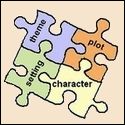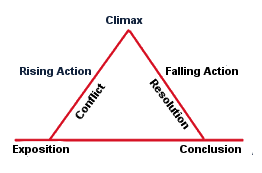Course 3—Lecture
| Article Index | Summary | Begin Lecture | Full Version |
|---|
|
How to Read: Finding meaning Reading |
| LitCourse 3 How to Read: Finding meaning |
1 |
|
Evaluating Literature W-R-O-N-G !
How is it possible to "ruin" literature by deepening our understanding of it? |
|
| LitCourse 3 How to Read: Finding meaning |
2 |
|
Evaluating Literature—why? As we deepen our understanding of literature . . . we deepen our understanding of life.
|
|
| LitCourse 3 How to Read: Finding meaning |
3 |
|
Evaluating Literature—how?
|
|
| LitCourse 3 How to Read: Finding meaning |
4 |
|
Evaluating Literature—how? • Click—"Reading" on the Course Tools to the right.
• Read—the short story, "Powder." • Return—to Slide #5 and continue this Lecture. |
|
| LitCourse 3 How to Read: Finding meaning |
5 |
|
Evaluating Literature—title Powder . . .
• covers the landscape—you can't see ahead, you can't see what's coming, you can't see the future. • creates a fresh new world—a world with new possibilities and a new way of seeing life. |
|
| LitCourse 3 How to Read: Finding meaning |
6 |
|
Evaluating Literature—setting • Weather—"bitter blinding snow" in the beginning; "fresh powder" at the end.
• Location—mountains, fast ski runs, and steep roads with hairpin turns. • Season—Christmas: hope for a new beginning. |
|
| LitCourse 3 How to Read: Finding meaning |
7 |
|
Evaluating Literature—plot
|
|
| LitCourse 3 How to Read: Finding meaning |
8 |
|
Evaluating Literature—plot • Exposition—the boy gives us background information about his family.
• Rising action—tension rises as Doc takes risks to get his son home on time. • Climax—the highpoint of tension comes as the boy removes the roadblock. • Falling action—the boy begins to relax and appreciate his father and the ride • Conclusion—we learn the parents eventually divorce. |
|
| LitCourse 3 How to Read: Finding meaning |
9 |
|
Evaluating Literature—character • Father—spontaneous (loves jazz), risk-taker, disregards rules (removes road barrier).
• Son—fears risk, orderly (clothes on numbered hangers), plans ahead (asks for homework in advance). • Mother—angry (perhaps justified), orderly, perfectionist (dinner candles waiting to be lit). |
|
| LitCourse 3 How to Read: Finding meaning |
10 |
|
Evaluating Literature —viewpoint • The son narrates the events of the story; we see what he wants us to see, through his perspective.
• He provides insight into his parents' differing personalities and their clash of values. • He is frank about his own fears and anxieties; later, he tells us about his epiphany—a new found respect for his father and new perspective on life. |
|
| LitCourse 3 How to Read: Finding meaning |
11 |
|
Evaluating Literature—symbols • Thelonius Monk (jazz musician)—unbound by convention; innovative, spontaneous, just like Doc.
• Christmas—a time of birth, new beginnings. • Powder—covers roadways and signs—there are no guideposts in life; creates a fresh, unknown world, open to new possibilities. • Roadblock—removing the roadblock "unblocks" the way forward into a new life for the son. |
|
| LitCourse 3 How to Read: Finding meaning |
12 |
|
Evaluating Literature—irony Doc is the opposite of a traditional father:
• undependable (never on time) • childlike in his love of thrill (wants one last ski) • dismissive of rules (removes roadblock) The son seems to be the mature one in the relationship. His exasperation with Doc resembles a father's attitude toward a teenage son. |
|
| LitCourse 3 How to Read: Finding meaning |
13 |
|
Evaluating Literature—theme Carpe diem theme—spontaneity and a degree of risk are essential for a vibrant life. To act only when one knows the exact outcome leads to a crabbed existence.
Coming-of-age theme—crossing from youth into adulthood means leaving behind childish ideas and entering a world of new understanding. |
|
| LitCourse 3 How to Read: Finding meaning |
14 |
|
Evaluating Literature—approaches |
|
| LitCourse 3 How to Read: Finding meaning |
15 |
|
Mythological criticism—looks for patterns that reflect timeless, universal myths. The Cinderella motif or the hero's journey are two enduring ones. And now . . . Congratulations! |
|
Site by BOOM
![]()
LitLovers © 2024


